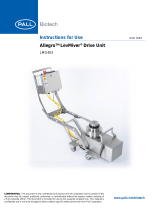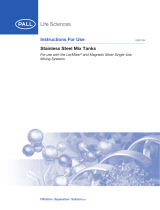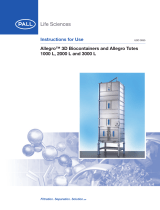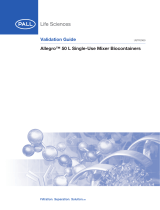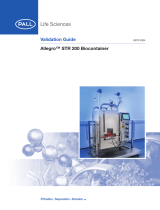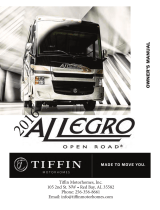Page is loading ...

Instructions for Use USD3294
AllegroTM Magnetic Mixer Drive Unit
MMG403
Filtration. Separation. Solution.SM

2
Table of Contents
1. Explanation of Symbols ................................................................................................. 3
2. Safeguards & Precautions ............................................................................................. 4
3. Introduction ................................................................................................................... 6
4. Specifications ................................................................................................................ 7
5. Mixing System Components and Accessories ............................................................... 8
6. Dolly – Tank Assembly ................................................................................................ 12
7. Allegro Mixing Biocontainer Installation ....................................................................... 14
8. Docking of the Drive Unit to the Tank and Biocontainer ............................................... 17
9. Operator Control Interface Guide ................................................................................ 21
10. Disconnecting Drive Unit from Tank ............................................................................ 35
11. Maintenance and Care ................................................................................................ 36
12. Spare Parts and Standard Accessories ....................................................................... 45
13. Service ........................................................................................................................ 46
14. Scientific and Laboratory Services............................................................................... 46
15. Electrical Diagram ....................................................................................................... 47
16. CE Certificate .............................................................................................................. 50
17. Warranty...................................................................................................................... 51

3
1. Explanation of Symbols
WEEE
Waste of Electrical and Electronic Equipment
CAUTION
HIGH VOLTAGE
PROTECTIVE EARTH
Ground
MAIN POWER SWITCH
CE CERTIFIED
STRONG MAGNETIC FIELD
May affect pacemakers
PACEMAKER OR OTHER MEDICAL DEVICE
Stay 33 cm (13 in) away until consulting with a physician

4
2. Safeguards & Precautions
1. Read and follow all instructions in this manual carefully, and retain this manual for
future reference.
2. Do not use this instrument in any manner inconsistent with these operating
instructions or under any conditions that exceed the environmental specifications
stated.
3. Be sure the power supplied to this instrument matches the specifications indicated
on the control box.
4. This instrument should not be lifted. If it is required to be moved, the device should
be rolled on a flat surface.
5. If the drive unit is transported or stored in temperatures colder than the operating
environment, it is necessary to wait 1-2 hours to equalize the internal temperatures
of the drive unit before powering on.
6. Rotation at mixing action being interrupted because of mains fault or alarm
generated will not restart upon restoring of working condition. Return to mixing
action available only through intentional operator actions.
7. Prior to servicing the drive unit, always turn the power off using the ON/OFF
switch on the front panel of the unit. Unplug and remove power cord to avoid
tangling or breaking.
8. For full compliance with CE specifications, be sure the appropriate ground
connection is made.
9. For technical assistance contact the sales organization from which you purchased
the product or Pall Biotech directly.
10. Each magnetic mixer biocontainer contains a magnetic impeller, which is a source
of strong magnetic field within close proximity (305 mm/12 in.) of the impeller.
PEOPLE USING ANY ELECTRONIC MEDICAL DEVICES, SUCH AS PACEMAKERS,
SHOULD NOT BE INVLOVED IN THE CLOSE HANDLING OF MAGNETIC MIXER
BIOCONTAINERS, IMPELLERS OR TEST IMPELLERS.
11. Keep the supplied magnetic shields on biocontainers and impellers when not in
use.
12. This instrument is not intended to be used with flammable liquids/substances or in
hazardous atmosphere. Use of the magnetic mixer with flammable
liquids/substances could lead to a fire, injury, or loss of life.
13. The machine is intended for indoor use in atmosphere not containing corrosive
substances.
14. The frame and body of the machine consists of 304 stainless steel and may be
cleaned with water and isopropyl alcohol.
NOTE: It is important to ensure the system is turned off before cleaning the device.

5
DO NOT open the machine or control box while the drive unit is plugged in.
DO NOT submerge the drive in water. The unit outer surfaces may be cleaned and
sanitized by wiping with a mild detergent solution.
DO NOT position the machine in the way that power switch on face panel is
difficult to operate.
DO NOT obstruct access to outlet where machine is plugged to power line. Keep
point of connection visually and physically easy accessible.
DO NOT cut the ground plug.
CAUTION disconnect all power before servicing.
WARNING risk of electric shock.
CAUTION disconnection of the protective earth connector may impair the
protection provided by the system.
ATTENTION mains outlet used to power the equipment must be within 3 meters of the
device and easily accessible.

6
3. Introduction
The magnetic mixer single-use system contains a bottom mounted disposable magnetic impeller
on a disposable bearing. The single-use magnetic impeller includes a proprietary bearing
assembly designed to minimize particulate generation.
The complete magnetic mixer system consists of an interchangeable magnetic drive unit and
proprietary magnetic impeller based biocontainers. The single-use Allegro mixing biocontainers
are placed in either round plastic tanks (on a supporting dolly) or cubical or round stainless steel
tanks. The drive unit docks with the dolly or stainless steel tank. The magnetic mixer drive unit is
coupled with the Allegro mixing biocontainer through connection interface. The activation of the
motor induces rotation of the in-biocontainer impeller resulting in the mixing action inside a closed
biocontainer.
The coupling of the in-biocontainer impeller with the drive unit is accomplished by magnetic
forces only, therefore no dynamic seals or shaft penetration inside the biocontainer is required.
The drive unit is mounted on a portable cart that can be easily disconnected from the
biocontainer and reconnected to another Allegro mixing biocontainer thereby allowing mixing in
multiple biocontainers of various sizes with a single drive unit.
The magnetic mixer MMG403 can be linked directly to Pall technology (such as the Pall MVP
single-use system or Pall SUTFF {single-use tangential flow filtration}) to allow those systems to
control the mixer as part of an automated, integrated solution. This control capability can also be
customized accordingly to link with other DCS or SCADA systems.
Optional additional functionality is provided through one of 2 automation controllers (advanced
and basic) which facilitate local integration of load cells and probes for use in the mixing
applications.
The mixing system hardware has three major components:
1. Magnetic mixer drive unit
2. Elevated retaining tank (either on dolly, for use with plastic tanks or with integrated legs
on stainless steel tanks)
3. Optional control box
The magnetic mixer reusable system can accommodate a variety of standard and custom-
designed disposable biocontainers and tanks available from Pall Biotech with a capacity range
from 30 L to 3000 L.
These ‘instructions for use’ cover the drive unit and docking the drive unit to the plastic or
stainless steel tanks. For more details on stainless steel tanks and optional control box, please
refer to the following instructions respectively:
• USD 3193: Allegro™ Cubical LevMixer® and Magnetic Mixer Tanks
• USD 3194: Stainless Steel ROUND Mix Tanks: For use with the LevMixer® and Magnetic
Mixer Single-Use Mixing Systems
• USD 3197: Allegro™ 2000 L Cubical Magnetic Mixer Tanks
• USD 3280: Allegro 3000 L Cubical Magnetic Mixer 3000 Tank
• USD 3295: Basic/Advanced Control Box for LMG403 and MMG403

7
4. Specifications
Table 1: Specifications
Footprint WxLxH:
40 x 114 x 89 cm (15.75 x 45 x 35 in.) - compact configuration
40 x 135 x 89 cm (15.75 x 53 x 35 in.) - extended configuration
Control box, cart, & mixer
enclosure material:
304 L stainless steel
Control box, Frame, Drive Box
surface finish
At least 1.2 μm Ra/ 47 μin Ra
Control box ingress rating:
IP 65
Drive Unit enclosure ingress
rating:
IP 23
Voltage:
100 – 230 VAC, 50/60 Hz,
Voltage fluctuation:
+/- 10%
Overvoltage Category:
II
Input Wattage:
Less than 250 W
Amperage:
100 V 2.2 A; 110 V 2.0 A; 230 V 1.0 A
Altitude rating:
1000 m
Operating environment:
Temperature 4-40°C, Max humidity 85%, avoid condensation
Pollution degree:
2 or better
Motor horsepower:
¼ hp
Power cord length:
600 cm (20 ft)
Power cord plug options:
US, Continental Europe, Swiss, Australia, Japan, UK
E-stop (present, yes/no, location):
Yes, face of control box
Minimum & maximum speed:
20 to 300 RPM
Connectors for remote control:
TURCK RSFPV61; RSFPV579; HUMMEL M23 male thread,
12-pin.
Cord sets for remote control are not supplied
Functions available from remote
control panel:
Motor – start, stop
Speed – adjustment, indication
Alarm – indication
Mode of control (remote/local) – indication
Signal type(s) for remote
output/control:
Rotation speed out 4-20 mA, motor control in 0-10 V, discrete I/O
signals relay contact type
Alarms generated:
Motor failure, speed off-range failure, E-stop activation
Operator interface type:
Touchscreen PLC
Noise level at operator position:
63 dB
Casters:
2x swivel (front), 2X stationary (rear)
Wheel material:
Polyurethane
Recipe storage:
Yes. Up to ten can be stored. Up to ten instructions in each recipe
are executed sequentially. Each instruction contains individual
programmable parameters: mixing time, pause time, and speed.
Password protection:
Operator level: access to protected function - start recipe run.
Supervisor level: access to protected functions - Recipe Editor,
Pause or Abort Recipe run, Switch of Control between Local to
Remote, adjustment of set up for reduced set of parameters.
Maintenance level: access to protected functions – Program Setup
parameters, System parameters and includes Supervisor level of
access.

8
5. Mixing System Components and Accessories
5.1. Component Overview
Below pictures show an overview of the key components of the Allegro magnetic mixer system.
Figure 1: Magnetic mixer drive unit MMG403 with 650 L cubical tank
Table 2: Overview of main components magnetic mixer system
B
Magnetic mixer drive unit
B1
Drive unit handle
B2
Drive unit control box
B3
Latch
B4
Drive head
B5
Guide bearings
B6
Driver box
B7
Front wheels
B8
Rear wheels
B9
Frame
C
Tank
B
C
B2
B4
B1
B3 B5
B6
B7
B8
B9

9
Figure 2: Accessory toolbox and content
Table 3: Overview of components in accessory toolbox
A
Accessory Toolbox
A1
US power cord
A2
EU power cord
A3
Magnetic clamp
A4
Combination wrench
A5
Centering aligner
A6
Test impeller
A7
Magnetic shield
A8
Clip for 25.4 mm (1 in.) drain valve
Figure 3: Round plastic tank
The drive-biocontainer interface and o-ring are delivered as part of the tank (Figure 4). They
provide a centered position of the drive head in the tank during drive docking and mixing. For
installation see instructions for use of the tank (provided with the tank).

10
Figure 4: Drive-biocontainer interface and o-ring
The magnetic clamp and centering aligner can be found in the tool box delivered with the drive
unit. They are used during installation of the Allegro mixing biocontainer to assure correct
positioning of the impeller in respect to the opening in the tank.
Figure 5: Centering aligner (left) and magnetic clamp (right)
5.2. Drive Unit Control Overview
Note: The drive unit enclosure is sealed for water/spray resistance (IP23). The control panel is
splash resistant (IP65).
External electrical connections are done with cables running along the frame.
The controls are located on the face panel of the control box (Figure 6). They are: Operator
Touchscreen Interface, Quick Adjustment Keys, Power Button, and Emergency Stop push button.
Other options including those for remote control through connectors are available on the bottom
panel of the control box as shown in Figure 7.
Most control functionality is provided to the user through the touchscreen interface including
activation of functions, display of process information and alarm status. The magnetic mixer can
be operated in one of three modes selected by the operator locally from the main menu screen:
• Manual mode of operation
• Automatic mode of operation
• Remote mode of operation
Each mode includes a specific set of functions to support processing requirements.
Additionally, there is locked mode of operation which represents variation of remote control from
an external system and is intended to support control of the mixer using other equipment such as
Pall MVP system.

11
In manual or automatic mode the drive unit is fully controlled from the local screen. Transfer to
locked mode of operation happens upon detaching of the plug from connector ALLEGRO I/O.
After detaching the plug from the control panel, the appropriate cable and plug (for example, from
the Pall MVP system) should be connected to allow for locked/remote operation. For modes of
operation other than locked mode, keep the plug inserted and tightened.
Figure 6: Control panel top
Figure 7: Control panel bottom
When the drive unit is powered on, it is immediately ready for mixing.
IMPORTANT! In case of emergency the operator can stop rotation of the motor by pressing the
emergency stop (e-stop) button on the control panel. This can be done during any mode of
operation. Doing so halts the rotation of the motor and activates the system failure mode while
leaving other functions of the drive unit in operation. To reset alarm, release the e-stop button by
pulling it up until it clicks, and then acknowledge the alarm on the touch screen.
For details of operation, see Section 9 Operator Control Interface guide.

12
5.3. Unpacking
The magnetic mixer is shipped in a wooden crate with foam insets to protect the unit during
transport. Make sure to store the tool box in the vicinity of the drive unit. The crate should be
retained in the event that the parts have to be shipped in the future. Remove any foam and
protective packaging from the drive unit before first use.
6. Dolly – Tank Assembly
In case the drive unit is used in combination with a plastic tank on dolly, the following
procedure(s) should be used for installation of the tank on the dolly. If using a stainless steel tank,
go to section 7.
6.1. Installation of Tank on Dolly
1. Both the dolly and tank have holes for drive unit coupling. Insert the drive/biocontainer
interface into this hole from below and apply the o-ring to secure as shown in Figure 8. It
is not necessary to remove or replace the interface after installation (i.e. after mixing or
between batches).
Figure 8: Installation of the drive-biocontainer interface on tank dolly with o-ring
2. Position the plastic tank on the dolly. The bottom of the tank has two holes: a small hole
for the biocontainer drain and a larger hole for the drive head. Line up the larger hole with
the drive port on the dolly. The tank hole should locate around the interface.
3. Tanks up to and including 350 L use a centrally located impeller and therefore use the
central port dolly configuration. The 500 L tanks use single-use systems with an off-center
impeller and therefore use the off-center port dolly configuration. See procedure below for
changing the dolly port configuration.

13
6.2. Changing Dolly Configuration Between Center and Off-Center Impeller Port
Determine which port configuration is required: central port (tanks sizes: 30 – 350 L tanks)
or off-center port (500 L tanks). Each rail of the dual port has an adjuster attached to the
rail with two screws. The right adjuster is marked with two dots and the left adjuster is
marked with one dot. The right and left rails of the port are also marked with two and one
dot respectively, see images below. Right adjuster should always be used with the right
rail and the left adjuster with the left rail.
Figure 9: Rail port orientation – showing left side vs. right
To set the rails for the central port position, set the right and left adjusters so that the side with word
‘CENTER’ is visible on both; see Figure 10. Ensure that the two dot marks on the right adjuster are
located next to the two dot marks on the rail and single dot mark of the left adjuster is located next to
the single dot mark on the left rail. Secure the adjusters with the screws provided.
Figure 10: Rail adjustments for central position (left and right side)

14
To set the rails for the off center port position set the right and left adjusters so that the side with
words ‘OFF-CENTER’ is visible on both; see Figure 11. Ensure that the two dot marks on the
right adjuster are located next to the two dot marks on the rail and single dot mark of the left
adjuster is located next to the single dot mark on the left rail. Secure the adjusters with the
screws provided.
Figure 11: Rail adjustments for off-center position (left and right)
7. Allegro Mixing Biocontainer Installation
The below procedure describes the basics of installing an Allegro mixing biocontainer in a tank.
For more detailed instructions, please refer to the instructions delivered with the stainless steel
tanks.
1. Locate the magnetic clamp and centering aligner (Figure 12). These parts are required for
proper Allegro mixing biocontainer installation and alignment. Inspect the centering aligner
for damage; if the center hole is deformed, torn or not concentric, discard and replace with
an undamaged centering aligner.
Assemble the clamp and aligner as shown in Figure 13.
Figure 12 & 13: Centering aligner (left) and magnetic clamp (right) so they look like the picture on the right

15
2. Verify the correct article code and expiration date. Remove the outer and inner packaging
bag by tearing open at the easy to tear notch (Figure 14) - DO NOT USE SCISSORS OR
OTHER CUTTING IMPLEMENTS. Retain the label from the inner packaging according to
the quality policies of your organization.
3. Visually inspect the Allegro mixing biocontainer for shipping damage or imperfections;
cuts, tears or punctures; film cracks that are externally rough/sharp to the touch (note:
white creases that are not sharp to the touch are typically not a cause for concern);
impeller detached from impeller seat/post; kinked tubing that cannot be unkinked;
damaged, missing or detached subcomponents. If any such imperfections are discovered,
contact Pall or the user organization’s quality group for advice on whether the Allegro
mixing biocontainer should be used.
4. A blue shipping disc is magnetically attached to the outside of the Allegro mixing
biocontainer, over the impeller seat. Reverse the Allegro mixing biocontainer to have
access to the magnetic impeller with the blue disc. Next, remove the blue shipping disc
(Figure 15) (retain this item; this will be used to secure the impeller during subsequent
Allegro mixing biocontainer disposal).
Figure 14: Removing blue shipping disc from Allegro mixing biocontainer
Figure 13: Opening packaging bags via the easy tear notch

16
5. Assemble the centering aligner and magnetic clamp on the impeller on the Allegro mixing
biocontainer as shown in Figure 16.
Figure 15 : Assembly of Allegro mixing biocontainer with magnetic clamp/aligner assembly
6. Place the Allegro mixing biocontainer in the tank by aligning the magnetic clamp with the
large port on the bottom.
Figure 16: Biocontainer tank assembly with round plastic tank
7. For round plastic tanks, gently pull the bottom drain tube through the drain port opening.
For other tanks, please refer to the specific instructions delivered with the tank.
8. Before filling the biocontainer, ensure that the bottom drain tube is clamped. If the
biocontainer contains an EZ-Drain, ensure the drain is fully closed and clamp the drain in
place using the provided plastic drain clip.
9. As the biocontainer starts to fill, gently pull the bottom surface of the biocontainer to
remove any wrinkles, especially near the impeller.
DO NOT exceed recommended biocontainer capacity.
DO NOT alter the tube and/or impeller configuration.

17
8. Docking of the Drive Unit to the Tank and Biocontainer
8.1. Drive configuration
The drive unit can be used in one of two configurations: standard or extended. The configurations
can be switched following the procedure described in Section 11.3.1.
Each configuration allows connection of the unit to different tank sizes using a universal latch as
shown in Figure 18. Positions 1 and 2 are in standard configuration; positions 3 and 4 are in
extended configuration.
The table below shows the different latch positions for each tank size.
Marks on the frame at each latch show proper positioning of the latch in combination with the
round plastic tanks
Figure 17: Different latch positions for drive unit
Table 4: Latch positions/configuration cubical tanks
Cubical Tank Latch Positions
Volume
Position
Stamp on frame
Configuration
50 L
2
(23) 15
standard
100 L
2
(23) 15
standard
200 L
2
(23) 15
standard
400 L
2
(23) 15
standard
650 L
4
(23) 15
extended
1000 L
4
(23) 15
extended
1500 L
4
(23) 15
extended
2000 L
4
(23) 15
extended
3000 L
4
(23) 15
extended
Position 1
Position 2
Position 3
Position 4

18
Table 5: Latch positions/configuration round tanks
Round Tank Latch Positions
Volume
Position
Stamp on frame
Configuration
30 L
2
(23) 15
standard
50 L
2
(23) 15
standard
100 L
2
(23) 15
standard
200 L
2
(23) 15
standard
350 L
2
(23) 15
standard
500 L
2
(23) 15
standard
1000 L
2
(23) 15
standard
2000 L
3
(20)
extended
2500 L
3
(20)
extended
Adjust the universal latch by following the steps shown in Figure 19.
Figure 18: Procedure to change position of latch
4. Pull up to remove the latch.
2. Rotate the latch clockwise until the axle
flats are aligned with the horizontal slots.
1. Initial latch position before removal
3. Slide the latch toward the drive head.

19
8.2. Docking of Drive Unit to Biocontainer
1. Remove the magnetic clamp from the biocontainer container assembly before coupling.
To remove the magnetic clamp, reach underneath the drive port and carefully pull the
magnetic clamp downwards until it is free from the biocontainer-tank assembly. Return the
magnetic clamp to the supplied accessories box for future use.
IMPORTANT NOTE: Do not remove the magnetic clamp before filling the biocontainer with
the minimum required volume!
Figure 19: Removal of magnetic clamp
2. Make sure that the universal latch is installed in the correct position to match the rail port
intended for connection. See Table 4 and Figure 18 for corresponding latch and port
positions. Pull the latch back towards the handle as shown in Figure 19 step 1.
3. Position the drive unit in front of the rails of the tank.
4. Push down on the drive handle and raise the front wheels off the ground. Align the guide
bearings on the drive with the tank guide rails.
Figure 20: Aligning drive unit on tank rails

20
5. Roll the drive unit along the rails all the way until the bearings come to a stop and rest in
the notch located at the end of the rails.
Figure 21: Drive unit pushed until stop on tank rails
6. Using the drive unit handle, lift the drive unit to a horizontal position. While holding the
drive unit in this position, pivot the latch toward the tank so that the cross bar rests on the
hooks in the guide rails.
Figure 22: Lift drive unit and latch to tank
7. Once completely docked, the drive unit can be powered on by plugging the power cord in
an appropriate power socket.
Note: Tanks may not look exactly as shown, but the drive installation procedure is the same,
regardless of the tank design.
CAUTION: Be careful to not trap fingers under the latch when locking the drive unit
onto the tank.
CAUTION: In case of tanks on wheels, DO NOT attempt to move the tank with the
drive unit handle while it is docked. Doing so might damage the drive unit. Always use
the tank push bar to move the tank.
/
